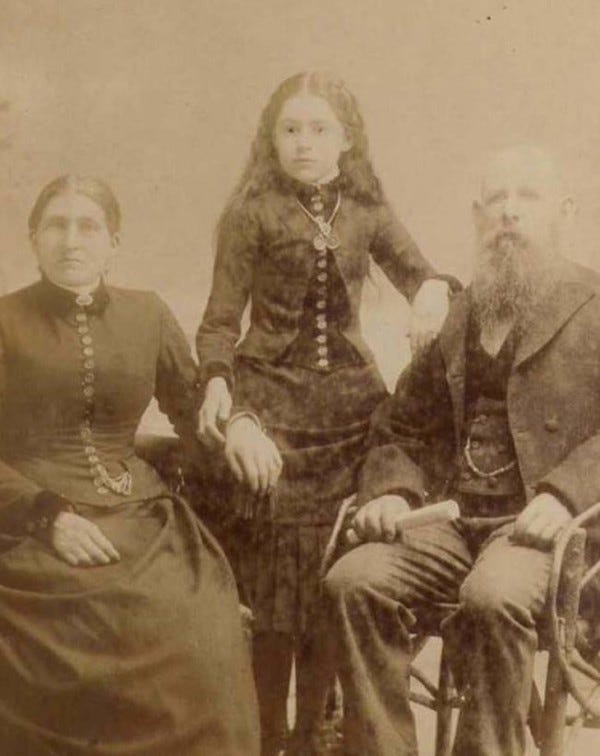The strangeness of post-mortem photography
While studying the history of photography, I came across articles about post-mortem photography. It’s a kind of photography that I’ve always found strange. Before explaining my thoughts, let’s talk about the history of post-mortem photography.
Photography was born in 1839 (but it’s, in fact, much older than that).
In 1839, thanks in particular to Arago, the daguerreotype became known throughout the world.
Although the exposure time was quite long, photographic portraits began to appear. It’s also at this time that post-mortem photography appeared. A post-mortem photograph is a portrait of a deceased person. It is said that this kind of portrait originated in England during the reign of Queen Victoria. This is probably true as there are many post-mortem photographs from the Victorian era.
Before the invention of photography, portraits of deceased people were made in sculpture, painting, moulding (death masks), etc. At that time, these portraits were mainly intended for important people (from the political, philosophical, artistic or religious world, for example) and for very rich people.
The invention of the daguerreotype was a great revolution. It was cheaper than other art forms, so more people could have access to it. But it was still quite expensive, and very new too. Therefore, for some people, a post-mortem portrait was the only portrait that relatives could have of the deceased. In addition, photography could provide a much more accurate portrait of people, compared to other artistic media.
Both the anonymous and the famous were photographed.
Many photographers and companies specialised in this type of portraiture, either in the studio or in the home of the deceased.
With the evolution of photography, such as the arrival of KODAK films,
families no longer hired professional photographers.
Post-mortem photography was very popular in the 19th and early 20th centuries, especially in Europe and America.
Among post-mortem photographs, there are a large number of photographs of deceased children, because at that time many children died in infancy (due to diseases such as chlorella, scarlet fever, etc.).
There are mainly two “types” of post-mortem photographs.
There are photographs in which the deceased person can be seen on their deathbed / in a coffin, giving the impression that they are asleep.
And there are staged photographs where the deceased person is standing or sitting (thanks to thanatopraxy and other tools), it can give the impression that the person is still alive. In both cases, the deceased may be surrounded by their living family (especially parents and/or siblings). A deceased baby may be sitting on its mother’s lap, for example.
Photographers didn’t hesitate to use objects (such as toys surrounding a deceased child) and props.
For the family, the post-mortem portrait was a way of remembering the person and their life and a way of paying tribute to them. In some cases, It was also a way to gather around the deceased person one last time. It could also be a way of accepting death. But also, for some people, the photograph could give the impression that the person was still alive.
The photographs could be kept in photo albums, framed and hung, or even sent to family members (thanks to André Disdéri’s invention).
I really understand that these portraits could help people to grieve. This last and sometimes only portrait was a way to keep an image of the deceased.
It was probably also a way of never forgetting how the person looked like and I find that totally understandable. Like many people, I’m always afraid of forgetting the faces of people I have loved.
Even though I understand this desire, I would never want to own this kind of portrait.
The only deceased person I have seen is my grandfather. And when I think about him, I think of when he was alive. I think about holidays, about the funny times like the time he showed me sheep droppings and made me believe there were sweets (I was a naive child haha).
Even though I remember the last time I saw him very well, and even though he looked peaceful and sleepy, that is not the memory I want to have of him.
I wouldn’t have wanted that moment to be photographed. Because the photograph taken would have reminded me of the sadness I felt at that moment and also, because, I think that the body is just “the envelope” of the person. What give the person their individuality, their personality, their soul, their spirit, disappear forever and… cannot be photographed and therefore preserved.
To be honest, I very rarely look at pictures of him because it reminds me that he’s no longer with us.
I also think that some post-mortem photographs look creepy.
I’m talking about the ones that are staged.
When you look at them, you can see that in many of them, the deceased have been manipulated. They’re standing up, or sitting with the help of props, and they’re sometimes surrounded by their relatives.
Like in the photograph below:

In this image, the young woman standing between her parents is the deceased. If you look closely, you can see the stand (specially designed for this kind of image) behind the young woman. This stand was used to keep the deceased upright.
You can also see that her eyes have been coloured (it was common in post-mortem photography, eyes and cheeks could be coloured during the development). We can easily understand that these tricks were used to give the impression that the girl was still alive.
This impression, the fact that the person, who’s right in front of us, is actually dead… is really strange and a bit creepy.
In fact, just think of the photo shoot (not the right word here): imagine the parents sitting between their daughter, and the photographer who put the young woman’s hands on the parents. I can’t help but think that it’s strange. Even though it clearly shows the parents’ love for their daughter.
I know that this portrait might have been the only “physical” memory of their daughter, but I also look at this staged photograph as a photo of denial of death. This image may be the only way to remember that the girl lived. It’s maybe the only way to remember that she was and always will be part of the family, that she was loved, but I also think it shows how desperately the parents tried to keep their daughter with them.
I have often made the connection between the film “The Others” and some of the post-mortem photographs, as I see the same ghostly and disturbing aspect in both. Maybe it has something to do with the monochrome and the textures of the photographs. Moreover, according to certain persons, some photographers used fading, which would easily explain the ghostly aspect.
As a photographer, I think that if I were asked to take this kind of portrait, I wouldn’t know what to do.
On the one hand, I’d want to say yes to the client because I’d understand them. But on the other hand, it would be very difficult for me.
I don’t think it’s morbid or disgusting. But I don’t know if I could do it. I’d be afraid of not being good enough.
I also think it has to do with my relationship to death that makes me feel that way. I want to keep death at a distance, to ignore it as much as possible and to be confronted with it as little as possible. Not to face it, in short.
Also, when I think about death and photographs, I think of a photograph taken by Nan Goldin, which shows Vittorio Scarpati in his coffin.
In general, I like Nan Goldin’s work a lot, but I have always found this photograph quite disturbing. I can’t say exactly what makes me feel this way, but I think it might be because the photograph looks too “real”, too “intimate”. It’s a bit contradictory to what I’ve written before, but I think there is a balance to be found in these portraits.
Nowadays…
While studying this subject, I read that post-mortem photography seems (I’m not sure about that) to be still practiced in some countries, especially in Eastern Europe.
I also learned that some people took selfies in front of open coffins, which they then posted on social networks… needless to say, I find this totally disrespectful and shocking.
I also read that a few years ago in France (I don’t know if it still exists), there was a company that proposed post-mortem photography services.
Maybe one day I’ll change my mind. Maybe one day the photographs of my grandfather will be a way to remember him and the moments we shared together. Maybe they won’t make me sad anymore.
And maybe one day, if I am asked to take a post-mortem photo, I will decide to go beyond my thoughts and say yes. Because taking this kind of photograph means helping those left behind.
And that is perhaps the most important thing.
